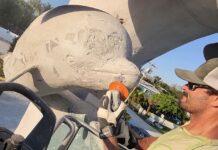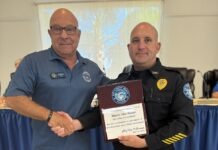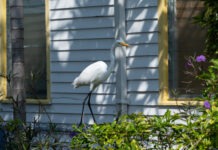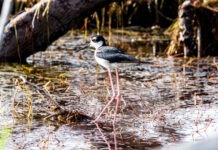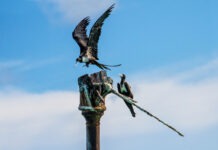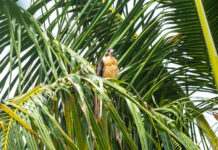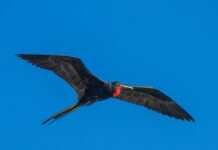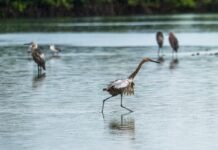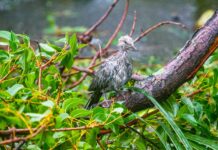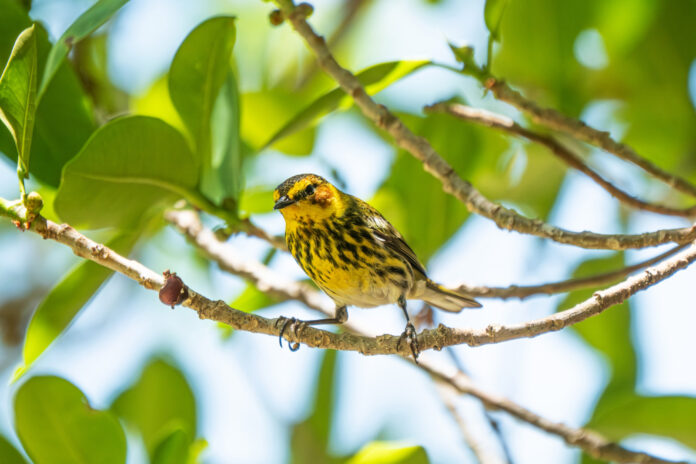
When I came through the entrance to the Key West Tropical Forest & Botanical Garden the woman who works in the gift shop gave me grief for referring to her as “the woman who works in the gift shop” in a column a couple weeks ago, and not using her name. She pointed out that I’d used a lot of other people’s names in this column. I pointed out that I’d known most of those guys for close to 20 years and that unfortunately I didn’t know her name at the time. But I do now. It’s Cindy Walker. Please accept this lede by way of apology, Cindy.
I’d been up in north Florida for a week, and then spent a few days catching up and had missed a lot of late April, which is generally the peak migration season here. We live in one of the best places in America to see migrating birds, but I was letting this hometown phenomenon slip by unseen, which made me question my bona fides somewhat as a birder.
May can be an interesting month, though. There’s still some chance for a fallout, as well as a decent number of late migrants. Also, the birds that have been gone all winter start to dominate the landscape.
I could tell it wasn’t going to be terribly birdy in the parking lot as I hadn’t even seen a grackle. But you miss 100% of the birds you don’t look for. and in recent years early May has actually been pretty good.
It took a while, but I did finally cross paths with a real live actual migrant – a common yellowthroat lurking low in the bushes on one of the back paths. I remember years ago, sitting with my friend, Julie Heath, in a hammock in Key Largo, where she was working with a team banding and measuring migrating songbirds. She had a male common yellowthroat (a species of warbler) in her hand. I was familiar with the bright yellow belly and the black mask across the eyes that made it look like he wanted to steal your silverware, but I never had noticed the delicate white fringe of feathers above the burglar mask.
“How can anyone call this bird common?” Julie said before releasing it.
Back at the botanical garden, the yellowthroat was working his way low through the shadowy foliage, his brilliance flashing as he moved through the occasional shaft of light.
In the bush above him I counted at least 80 Atala butterflies – the Lower Keys celebrity butterflies of the season, not seen here last year – lounging on the leaves.
Zipping around the Atalas, and from bush to bush, was a Tantalus sphinx moth, which regularly convinces people it’s a bee hummingbird, the smallest bird in the world, native to Cuba. Except it’s not. It looks totally different – a brown or brownish green, compared to the shiny blues and greens of the bee hummingbird. The Tantalus sphinx moth is very small, though, and does look kinda sorta like a hummingbird, so much so that we often get emails at the Florida Keys Audubon Society from people saying they’ve seen a bee hummingbird in their backyard. I came up with a form letter reply that aims to gently let people know they are mistaken, though it doesn’t always get a happy response.
I tried to get a photo of this particular Tantalus Sphinx moth, but it moved too quickly and everything I shot was a fuzzy blur.
Out on the patio area, next to the pond, a trio of gray kingbirds were chasing after each other. I spent a bit of time trying to figure out the social dynamic. Were they three males competing for territory? Were two males competing to attract a female? Was something else going on? It would be helpful if one could tell the males from the females, but that is not the way with gray kingbirds, which are essentially androgynous. Their ways are a mystery, clearly understood only by their own kind.
As I was walking toward one of the tables, a common grackle shot by, a flash of purple haze iridescence disappearing into a bush.
A minute or two after I sat down, a palm warbler came hopping up in the grass with the telltale tail twitch. We get so many of them in the winter, but this one, he or she (palm warblers are another sexually monomorphic species) should have skedaddled north by now.
More than a few of us have decided to stay in the Keys for the summers when we should have headed north, but that generally isn’t the case with birds.
I caught sight of a blackpoll warbler in the fruiting ficus tree overhead, a male with his orange legs and Moe-from-the-Three-Stooges mop of black feathers on his head, which was not unexpected. They usually bring up the rear in the fall migration.
Blackpolls are interesting because they go against the basic migration paradigm. Most migratory North American species head south in the fall in a leisurely manner, and return with something of a fervor to claim territory and find a mate in the spring. Blackpolls take an incredibly risky route to South America, leaving the coast of New England and flying 3,000 miles across open water in the fall, but then take a safer, slower overland route north to their boreal breeding territories in the spring.
A few minutes later, in the same tree, was a Cape May warbler, a species I’m always happy to see, though I have something of a quibble with the name. Cape May is a damn wonderful shore town at the southern tip of New Jersey, and smart like Key West in the preservation of its ornate historic architecture. It is one of the great places in the world to bird, partly for its geography and habitats, but also because with so many really good birders living there, not much gets missed. But that species also breeds in the boreal forests of Canada and the extreme northern parts of a few states. They are named for Cape May because the first specimen was captured there during migration.
Their Latin name is Setophaga tigrina, the tigrina part meaning tiger-like in appearance, because their breasts are a dynamically streaked gold and black. I’m considering starting a petition, once the American Ornithological Society finishes renaming all the birds named for people, to rename the bird the tiger warbler, which would be much cooler, though possibly not favored by people from South Jersey.
When I ran into Amy Grimm a little later, I told her I felt I’d missed the best parts of migration this spring by being out of town. She said I hadn’t really missed much. The weather had been clear and the birds had largely been flying over without stopping. Which made me feel a little better about my life choices.
I headed out after that, making sure to say goodbye to Cindy Walker as I left.




